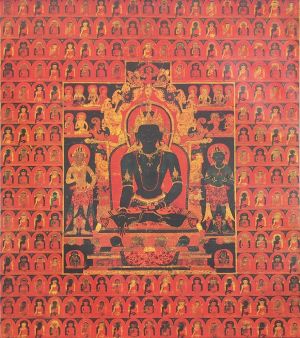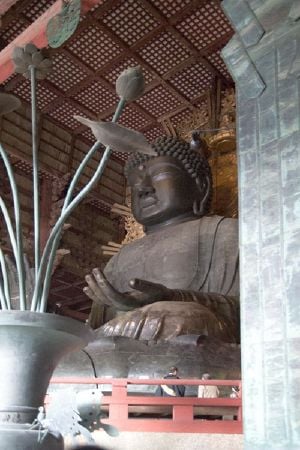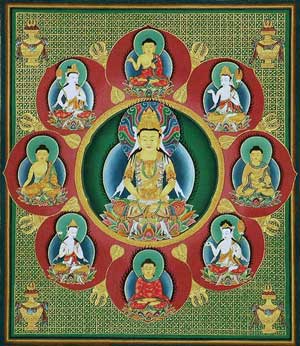Vairocana
Vairocana (also Vairochana or Mahāvairocana; वैरोचन Sanskrit or 毘盧遮那佛 Chinese: Dàrì Rúlái or Piluzhenafo, Korean, "Birokana," Japanese: Dainichi Nyorai, 大日如来; Tibetan: རྣམ་པར་སྣང་མཛད། rNam-par-snang mdzad; Mongolian: Teyin böged geyigülügci; Vietnamese: Đại Nhật Như Lai) is a Buddha who is the embodiment of Dharmakaya, and which therefore can be seen as the universal aspect of the historical Gautama Buddha. In Sino-Japanese Buddhism, Vairocana is also seen as the embodiment of the Buddhist concept of shunyata or Emptiness.
In the conception of the Five Wisdom Buddhas of Vajrayana Buddhism, Vairocana is at the center. The Vairocana statue in Nara's Tōdai-ji in Japan is the largest bronze image of Vairocana Buddha in the world. The larger of the monumental statues that were destroyed at Bamyan in Afghanistan was also a depiction of Vairocana.
The doctrine of Vairocana Buddha is based largely on the teachings of the Mahavairocana Sutra (also known as the Mahāvairocana-abhisaṃbodhi-tantra) and to a lesser degree the Vajrasekhara Sutra (also known as the Sarvatathāgatatattvasaṃgraha Tantra). Vairocana features prominently in the Chinese school of Hua-Yen Buddhism, and also later schools including Japanese Kegon Buddhism, and Japanese esoteric, or Shingon Buddhism. In the case of Shingon Buddhism, Vairocana is the central figure.
In Sino-Japanese Buddhism, Vairocana was gradually superseded as an object of reverence by Amitabha Buddha, due in large part to the increasing popularity of Pure Land Buddhism, but Vairocana's legacy still remains in the Tōdai-ji temple with its massive bronze statue and in Shingon Buddhism, which holds a sizeable minority among Japanese Buddhists.
Vairocana is not to be confused with Virocana, who appears in the eighth chapter of the Chandogya Upanishad as the king of the Asura.
Doctrine
In the Rigveda of Hinduism, the word ‘vairocana' has the connotation of a brilliant and luminous sun. Indeed, Vairocana in Tibetan is called ‘Namnang' (rnang.par snang.mdzad), meaning ‘the illuminator', and the Japanese 大日(Dainichi) translates as "Great Sun."
In the Buddhist Mahavairocana Sutra, Vairocana teaches the Dharma to Vajrasattva, but it is utterly incomprehensible, so Vairocana provides esoteric techniques and rituals to help conceptualize the Dharma beyond verbal form. It was this sutra that prompted the Japanese monk, Kukai to journey to China to learn more about Tantric Buddhism.
Vairocana often displays the Dharmacakra mudrā. Dharmacakra in Sanskrit means the Wheel of Dharma. This mudra symbolizes one of the most important moments in the historical life of the Buddha, the occasion when he preached to his companions the first sermon after his Enlightenment in the Deer Park at Sarnath. It thus denotes the setting into motion of the Wheel of the teaching of the Dharma.
Vairocana is an idealization of this central function of the Buddha as a teacher, without which there would have been no Buddhism, and no path to enlightenment. While Amitabha Buddha is seen as a personification of Compassion (balanced by Wisdom), Vairocana is often seen as a personification of Wisdom.
Iconography
Significantly, Vairocana is said to be the sum of all the Dhyani Buddhas and combines all their qualities. He is therefore, pure white, since white is a blend of all colors.
Indeed, his lotus seat is supported by a pair of two great lions. The lion is the king of beasts and when he roars all others fall silent. Similar is the roar of Buddha's teachings, in relation to the grandeur of which all other voices of our everyday life become insignificant and fall silent. Not surprisingly, meditating on the image of Vairocana is specifically believed to transform the delusion of ignorance into the wisdom preached by the Dharma. When Gautama Buddha turned the wheel of the Dharma, it illuminated (like a sun), the hearts of men and women darkened by ignorance.
With regard to Emptiness, the massive size and brilliance of Vairocana statues is intended to serve as a reminder that all existence is empty, and without a permanent identity.
Vairocana's distinguishing emblem is the golden or solar wheel.
Five Dhyani Buddhas

In Vajrayana Buddhism, the Five Dhyani Buddhas (Dhyani ध्यानि Skt. for "concentration"), also known as the Five Wisdom Buddhas (五智如来 gochinyōrai), the Five Great Buddhas and the Five Jinas (Skt. for "conqueror" or "victor"), are representations of the five qualities of the Buddha. The term "dhyani-buddha" is first recorded in English by the British Resident in Nepal, Brian Hodgson,[1] in the early nineteenth century, and is unattested in any surviving traditional primary sources. These five Buddhas are a common subject of Vajrayana mandalas.
The Five Wisdom Buddhas are a later development, based on the Yogācāra elaboration of concepts concerning the jñāna of Buddhas, of the Trikaya (Skt. Tri is "three," kaya is "body") theory, which posits three "bodies" of the Buddha. The Wisdom Buddhas are all aspects of the dharmakaya or "reality-body," which embodies the principle of enlightenment. Initially two Buddhas appeared which represented wisdom and compassion - they were, respectively, Akṣobhya and Amitābha. A further distinction embodied the aspects of power, or activity, and the aspect of beauty, or spiritual riches. In the Sutra of Golden Light (an early Mahayana Sutra) the figures are named Dundubishvara, and Ratnaketu, but over time their names changed to become Amoghasiddhi, and Ratnasaṃbhava. The central figure came to be called Vairocana.
It should be noted that when these Buddhas are represented in mandalas, they may not always have the same color or be related to the same directions. In particular, Akṣobhya and Vairocana may be switched. When represented in a Vairocana mandala, the Buddhas are arranged like this:
| Akṣobhya
(east) |
||
| Amoghasiddhi
(north) |
Vairocana
(principal deity/ meditator) |
Ratnasaṃbhava
(south) |
| Amitābha
(west) |
Names in other languages:
| Buddha | Sanskrit | Japanese | Chinese | Tibetan |
|---|---|---|---|---|
| Vairocana | Vairocana | 大日如来, Dainichi Nyorai | 毘盧如來, Pilu Rulai | Nampar nangdze, Nam nang |
| Akṣobhya | Akṣobhya | 阿閃如来, Ashuku Nyorai | 阿閃如來, Ajiu Rulai | Mitrugpa |
| Amitābha | Amitābha | 阿弥陀如来, Amida Nyorai | 彌陀如來, Mituo Rulai | Wöpakme |
| Ratnasaṃbhava | Ratnasaṃbhava | 宝生如来, Hōshō Nyorai | 寳生如來, Baosheng Rulai | Rinchen Jung ne Rin jung |
| Amoghasiddhi | Amoghasiddhi | 不空成就如来, Fukūjōju Nyorai | 成就如來, Chengjiu Rulai | Dön yö drub pa Dön drub |
There is an expansive number of associations with each element of the mandala, so that the mandala becomes a cipher and mnemonic visual thinking instrument and concept map; a vehicle for understanding and decoding the whole of the Dharma. Some of the associations include:
| Family | Buddha | Wisdom | Neurosis/Poison | Skandha | Action Activity | Symbol Implement | Element | Color | Season | Cardinal Direction | Mudra |
|---|---|---|---|---|---|---|---|---|---|---|---|
| Buddha | Vairochana | all accommodating | ignorance | form | Turning the Wheel of Dharma (teaching) | wheel | space | white | n/a | center | teaching the Dharma |
| Ratna | Ratnasambhava | equanimity equality | greed pride | feeling | enriching, increasing | jewel | earth | gold, yellow | autumn | south | giving |
| Padma | Amitabha | discriminating awareness | desire | perception | magnetizing, subjugating | lotus | fire | red | spring | west | meditation |
| Karma | Amoghasiddhi | all accomplishing | envy | mental formation, concept | pacifying | sword | air, wind | green | summer | north | fearlessness |
| Vajra | Aksobhya | mirror like | hatred anger | consciousness | protecting, destroying | scepter, vajra | water | blue | winter | east | earth-touching |
The Five Wisdom Buddhas are protected by the Five Wisdom Kings, and in Japan are frequently depicted together in the Mandala of the Two Realms.
Each of the five Buddhas first identifies a specific human failing and then helps us in transforming it into a positive attribute, bringing about the spiritual evolution required for enlightenment.
Miscellaneous
During the initial stages of his predication in Japan, the Catholic missionary Francis Xavier was welcomed by the Shingon monks since he used the word Dainichi for the Christian God. As Xavier learned more about the religious nuances of the word, he changed to Deusu from the Latin and Portuguese Deus. The monks also realized by that point that Xavier was preaching a rival religion.
Sources
- Bogle, George; Markham, Clements Robert; and Manning, Thomas (1999) Narratives of the Mission of George Bogle to Tibet and of the Journey of Thomas Manning to Lhasa ISBN 812061366X
- Bucknell, Roderick & Stuart-Fox, Martin (1986). The Twilight Language: Explorations in Buddhist Meditation and Symbolism. Curzon Press: London.
- Cook. Francis. Hua-Yen Buddhism: The Jewel Net of Indra. Pennsylvania State University Press, December 1977.
- Vessantara. Meeting The Buddhas, Sheffield : Windhorse Publications, 1993. ISBN 0904766535.
- Wayman, Alex and R. Tajima Motilal. The Enlightenment of Vairocana: Study of the Mahavairocana-Sutra. Banarsidass Publisher, 2005. ISBN 978-8120806405
External links
- Mahavairochana Museum Exhibit Retrieved September 20, 2008.
- Mantras of Vairocana Retrieved September 20, 2008.
- Cosmic Sun Buddha MahaVairocana Retrieved September 20, 2008.
Credits
New World Encyclopedia writers and editors rewrote and completed the Wikipedia article in accordance with New World Encyclopedia standards. This article abides by terms of the Creative Commons CC-by-sa 3.0 License (CC-by-sa), which may be used and disseminated with proper attribution. Credit is due under the terms of this license that can reference both the New World Encyclopedia contributors and the selfless volunteer contributors of the Wikimedia Foundation. To cite this article click here for a list of acceptable citing formats.The history of earlier contributions by wikipedians is accessible to researchers here:
The history of this article since it was imported to New World Encyclopedia:
Note: Some restrictions may apply to use of individual images which are separately licensed.
- ↑ Bogle (1999) pp. xxxiv-xxxv

